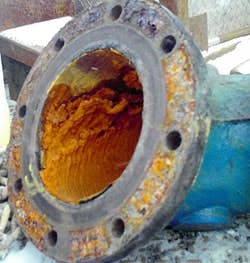Cleaning Up the Mains
Located in Shiawassee County, Mich., the city of Perry is located 10 miles east of Lansing. While Perry's roots are in industry and commerce, more recently its proximity to Interstate 69 has caused the small community of 2,000-plus to grow as a bedroom community for Lansing commuters.
All of Perry's potable water comes from a well field with three wells supplying a combined 220,000 gal per day to 755 connections. Iron levels in the town's water supply had been a nagging problem dating back to the early 1960s. While there were no regulatory problems with the 2-mg/L iron levels, they nevertheless exceeded the U.S. Environmental Protection Agency’s recommended Secondary Maximum Contaminant Levels (MCLs) of 0.3 mg/L. More importantly, community feedback pointed to clear aesthetic problems with taste and color, and problems had also been reported of iron in fixtures and of discolored laundry. To help alleviate the problem, the city’s operations staff flushed the mains three times per year and fed phosphates, but the problems persisted as the city’s treatment did not provide iron removal.
In 2005, aided by funding from the State Revolving Fund, the city of Perry contracted with a consulting firm and began looking into treatment options. Layne Christensen Co. conducted a filtration pilot study using its manganese dioxide-based media, LayneOx, and demonstrated that iron and manganese could easily be removed to levels below the secondary MCL. LayneOx is a highly efficient granular catalytic filter media with naturally high manganese dioxide content. The LayneOx process provides the ability to remove many contaminants, including iron, manganese, hydrogen sulfide and arsenic, all in one cost-effective backwash process.
Based on the results of the pilot study, the consultant proposed the construction of a full-scale iron and manganese removal plant , installation of 4,000 ft of water and sewer main, the drilling of one new well and the abandonment of an existing well. Prior to construction, a fourth well was installed in December 2007 followed by the abandonment of Well no. 2. Well installation and abandonment was performed by Layne and Reynolds Inc., a Div. of Layne.
Construction of the treatment plant began in the summer of 2008, initiated with a groundbreaking on June 12, 2008, at the well site. The project also indirectly benefited the community, as much of the work was contracted locally. The skid-mounted treatment plant was designed and constructed off site by Layne Christensen, and consisted of four 5-ft-diameter vessels, each with a loading rate of 6.37 gm/sq ft. Overall the system is rated for 500 gal per minute. Backwash is fully automated, initiated primarily on a timed basis and secondarily based on pressure drop.
The project was punctuated by a spirit of teamwork and cooperation. Notably, the consultant worked with the city to value-engineer the project, optimizing construction costs and localizing contract work. Work was completed in the winter of 2009.
System Performance
The finished iron levels are now below 0.1 ppm after backwash, and customer complaints have decreased dramatically. Mains continue to be flushed, but now only twice a year to clear residual iron remaining from previous production. As the residual iron dissipates, the quantity of water used per flush has also decreased from 800,000 to 150,000 gal. Phosphates are no longer necessary, saving approximately $2,000 annually in chemical costs while also eliminating phosphate loading to the wastewater treatment plant.
The client noted that there has been not a single problem with the system since it went online, and was generally pleased with the way Layne stood by their side through the design and installation process. The client said the city is pleased with the system’s performance, cost, ease of use and, notably, the system automation. The automated system exceeded expectations and the operators were not unduly burdened with issues of operation and maintenance. The client even noted that the city has experienced a reduction in the use of home water softeners.
David Osgood is marketing manager, Layne Christensen Co. Contributing authors include Jim Groose, water treatment specialist, Layne Christensen Co.; Mike Tracy, P.E., senior project engineer; and Chris Zeeb, Layne project manager.
